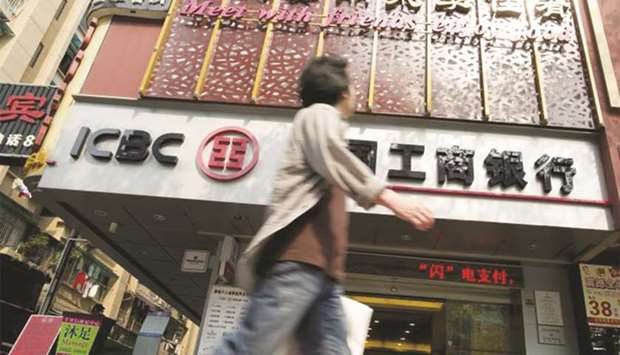China’s banks made the most new loans on record in January – totalling 3.23tn yuan ($477bn) – as policymakers try to jumpstart sluggish investment and prevent a sharper slowdown in the world’s second-largest economy.
Chinese banks tend to front-load loans early in the year to get higher-quality customers and win market share.
But they have also faced months of pressure from regulators to step up lending, particularly to cash-starved smaller firms.
Net new yuan lending last month was far more than expected, and eclipsed the last high of 2.9tn yuan in January 2018.
Analysts polled by Reuters had predicted new loans of 2.8tn yuan, more than double the level seen in December.
“While we wouldn’t pin too much on a single month’s data, the latest pick-up in credit could be a sign that credit growth is starting to bottom out in response to monetary policy easing,” Julian Evans-Pritchard, senior China economist at Capital Economics, said in a note.
“A recovery in lending, if sustained in coming months, would be consistent with our expectation for growth to stabilise in the second half of this year,” he said, noting it usually took six to nine months before new loans translated into business activity.
Sources told Reuters last week that the central bank had urged banks to moderate lending in January to manage the amount of money flowing into the economy, spurring talk that the tally would be even more robust than first thought.
Demand for credit picked up sharply in the corporate sector, followed by the household sector, according to data released by the People’s Bank of China (PBoC) yesterday.
Corporate loans jumped to 2.58tn yuan from 473.3bn yuan in December, while household loans rose to 989.8bn yuan from 450.4bn yuan, according to Reuters calculations based on the PBoC data.
Corporate loans accounted for 80% of new loans in January, up sharply from 44% in December.
That will be welcome news for policymakers, who have been struggling to get money to the private sector, which accounts for over half of China’s economic growth.
The central bank has not opened the credit floodgate, and the record January lending showed monetary policy had become more effective, a central bank official said, in a bid to allay concerns about more debt build-up.
To free up more funds for lending, the central bank has cut the amount that banks need to set aside as reserves five times over the past year.
In the latest move, the PBoC slashed the reserve requirement ratio (RRR) in January by 100 basis points (bps), and analysts expect at least another 150 bps of cuts by year-end.
Most analysts do not expect the central bank to cut benchmark interest rates soon, though some aren’t ruling out more aggressive easing if conditions continue to deteriorate or the China-US trade war escalates.
The PBoC has been guiding money market interest rates lower to reduce financing costs, but analysts at JP Morgan said in a recent note that banks have not lowered average lending rates.
While the PBoC has been pushing ample funds into the financial system, the money has not been flowing smoothly into the economy and generating growth.
Banks have been wary of lending to smaller firms with higher credit risks, preferring state-backed customers, while businesses are reluctant to take on more debt when sales and profits are weakening.
Several bankers told Reuters they were keen to avoid repeating excessive and riskier lending that followed a massive stimulus package during the global financial crisis.
Banks’ non-performing loan ratio climbed to a 10-year high in 2018 and corporate bond defaults hit a record.
Still, strong credit expansion should help efforts to boost fixed asset investment.
Regulators have been fast-tracking approvals for infrastructure and are trying to streamline financing so projects roll out more smoothly.
Significant tax cuts are also expected this year to help ease strains on corporate balance sheets.
“January credit data are very positive as it shows all easing measures including monetary easing, fiscal easing and administrative easing are taking effect,” said Tommy Xie, China economist at OCBC Bank in Singapore.
Growth measures will take time to be felt, and many analysts believe business conditions will get worse before they get better.
China grew 6.6% last year, a 28-year low.
Data earlier yesterday showed factory-gate inflation slowed for a seventh straight month, raising concerns China may see the return of deflation as demand cools.
Several other key credit gauges also picked up modestly in January in response to the PBoC’s recent shift to policy easing.
Broad M2 money supply grew 8.4% on-year, also beating forecasts.
Analysts had expected growth to inch up to 8.2%, after falling to a record low late last year.
Outstanding yuan loans grew 13.4%, above expectations of 13.1% but easing from December’s rise of 13.5%.
Growth of outstanding total social financing (TSF), a broad measure of credit and liquidity in the economy, picked up to 10.4% from a record low of 9.8% in December.
TSF includes off-balance sheet forms of financing that exist outside the conventional bank lending system, such as initial public offerings, loans from trust companies and bond sales.
That can provide some clues on activity in the vast and unregulated shadow banking sector, which authorities have been targeting in a campaign to reduce systemic financial risks.
Combined trust loans, entrusted loans and undiscounted bankers’ acceptances, which are common forms of shadow banking finance, rose by 343.2bn yuan in January, following a slide of 2.93tn yuan in the whole of 2018.
“The return of trust financing to positive shows that China may ease its grip on shadow banking to support those reasonable shadow banking activities,” OCBC’s Xie said.

An Industrial and Commercial Bank of China branch in Beijing. China’s banks made the most new loans on record in January u2013 totalling 3.23tn yuan ($477bn) u2013 as policymakers try to jumpstart sluggish investment and prevent a sharper slowdown in the world’s second-largest economy.


